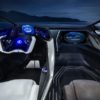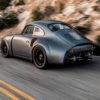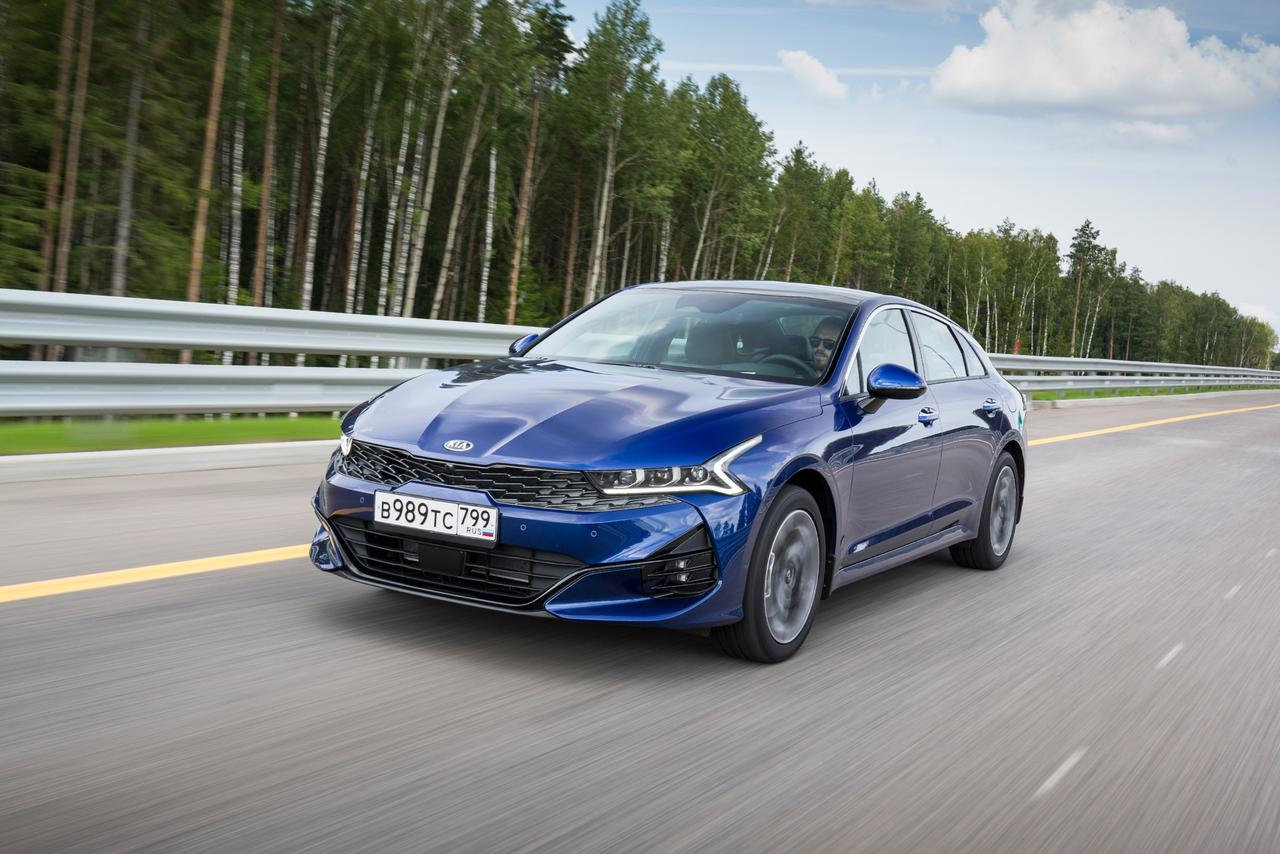There is a cliché in auto-press: when the author does not have enough imagination for a headline about a new generation of a model, he calls the text “Only the name remains the same”. But with the Kia K5, this technique will not work – the car that we have always known as Optima, now even named differently. But why change a resounding brand name to a faceless alphanumeric code? In general, this is what this model has been called in China and South Korea for the past ten years. Yes, and in our country, some owners practice replacing Kia badges with K5 – emphasizing something by this. Now they have to come up with another way to stand out because the Kia brand has decided to globalize the K5 nameplate. And there is a convenient explanation – this car is completely new.
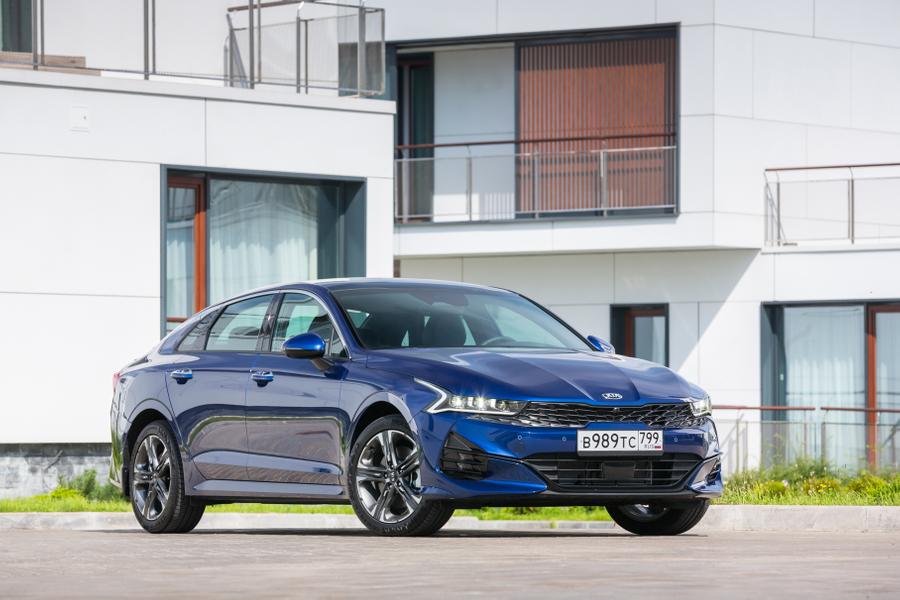
The start of sales of Kia K5- September 1. There are 10 versions available, which are a combination of two motors and seven trim levels. Price range – from $20K to $30K.
The past was also completely new, but it is easy to confuse it with its predecessor, and many of the units they had in common. You can’t say the same about the new Optima (sorry, K5) – the style of the body and interior has been redesigned very much, and there are also other engines and transmissions (but not all). It’s all so different that the name change looks even natural. Apart from a small nuance – one letter accompanied by one number hardly reflects the design expression of the new model’s body.

The palette of colors for such a spectacular body is somewhat surprising: of the seven options, only one is bright – just the blue shown in the pictures
Surprise here and now
The Kia K5 is drawn with the same approach as the Hyundai Sonata – surprise here and now. Such forms do not become classics, but the momentary wow effect is powerful. In front and rear lighting equipment – diode strokes in the form of a cardiogram; chrome molding on the C-pillar adjusts the figure, turning a regular sedan into a slender pseudo-fastback; narrow headlights and a steep bonnet give the appearance of a healthy impudence, and the optics hood across the entire width of the stern – high cost and “trendiness”.
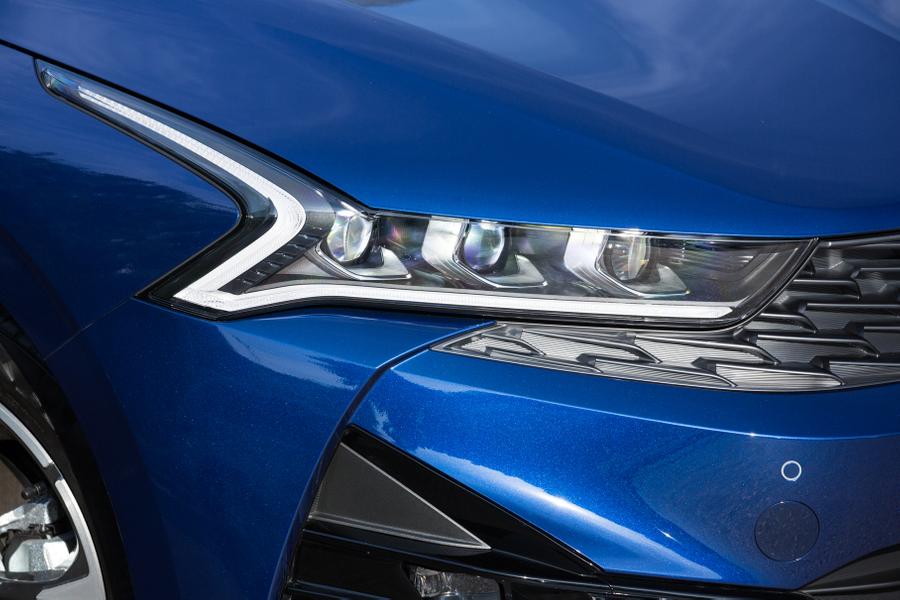
Kia could not afford to lag behind Hyundai (remember the Sonata’s “daytime lights” that turn into shiny moldings with a gradient?) And decided to radically experiment with light graphics
But you don’t need to look closely to understand: almost all “air ducts” are decorative, including the “pipes” in the rear bumper. However, form without functionality, but with a hint of it, is the modern norm in body design among a good half of manufacturers. However, this trend has made its way into interiors to a much lesser extent. The original performance of one or another piece of hardware in K5, if it affects usability, is in the best way. And cute things, like the corrugated aluminum frames of the climate ducts or the glossy tide-handles on the door armrests, are constantly tempting to touch. True, a smart salon quickly builds up prints on its shiny surfaces and starts to look less presentable.

The steering wheel in the basic version for $20K will be with a plastic rim, so the “real” starting price is the second complete set for 1.61 million. But there will also be a monochrome screen of the radio tape recorder instead of this luxurious 10-inch display, and the tidy screen is three times more modest diagonally
There are some cool solutions that pull even mini-innovations in the classroom, and even in the industry in general. How many times, sitting in the front right, have you reclined your back to relax and unwind on a long journey? Now the passenger can do it with the press of one button – the K5 seat has a special “zero gravity pose”! When activated, the pillow and backrest take a position in which the sitting person relaxes as much as possible – the necessary angles were selected by Kia interior designers in conjunction with NASA specialists.
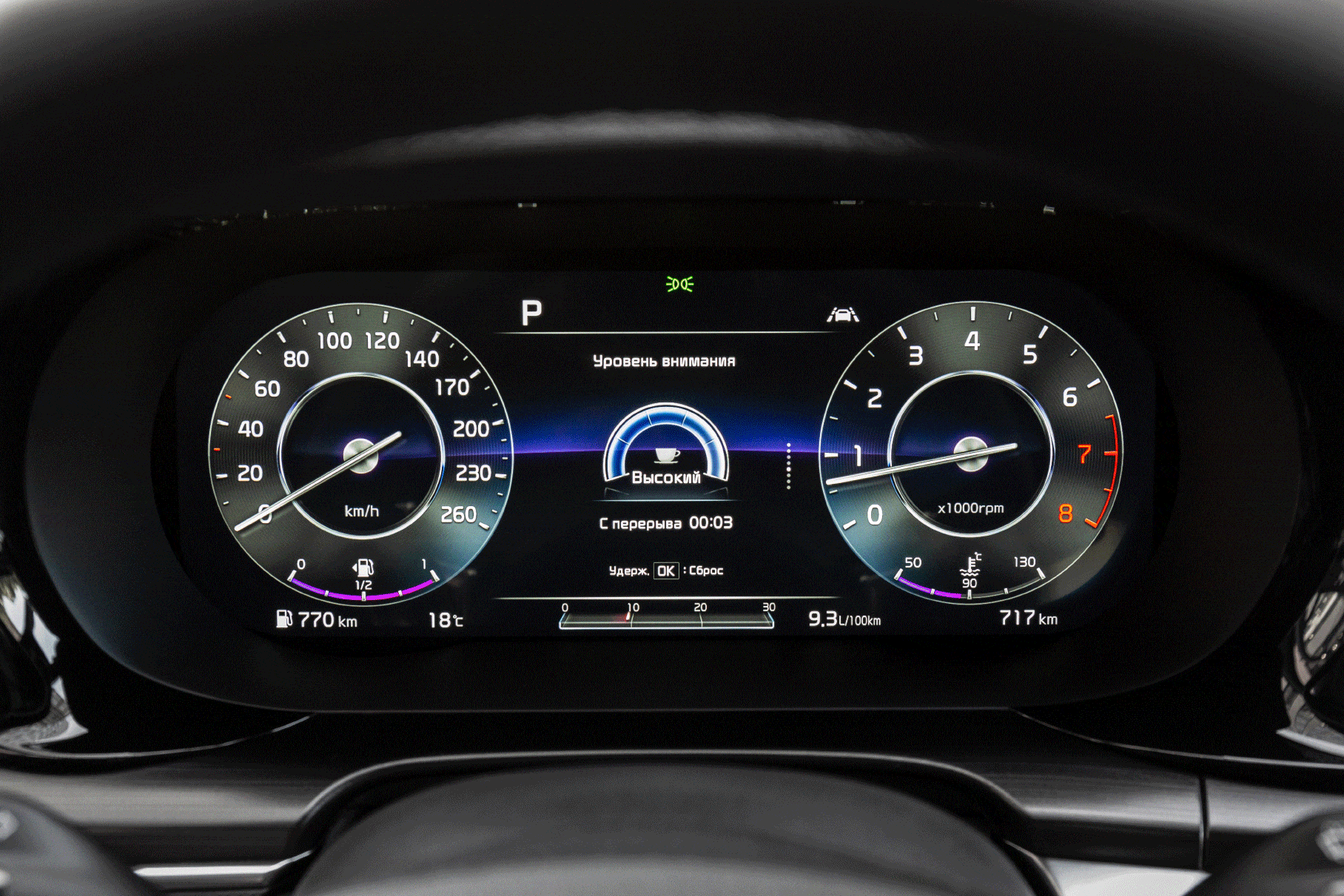
The tidy is nicely drawn and can look completely different. A new function has been added to the basic “skins” of various driving modes: mood “wallpapers” that change depending on the time of day – you can go into the sunset and watch the picture of the sunset on the dashboard. And when you turn on the turn signals, the graphics in the drawn scales are temporarily replaced by a picture from the blind zones monitoring cameras – it’s convenient. The image from all external “eyes” is of almost “goofy” quality!
Only in this case, you will not envy the rear passenger – even in spite of the huge reserve of space in the knees (the wheelbase has grown by 45 mm), the “cosmonaut” will somehow press the rear passenger. However, the functions of the seat are duplicated on the inner end of the backrest, so that any passenger can move it. The stocks in width and ceiling are also solid. The only thing is a little lack of coziness: there are no curtains on the windows; there is no third climate control zone; there is no shelf for a mobile phone, although there are a couple of ports for charging.
The top multimedia system is good both in functionality and performance. It connects two Bluetooth devices at the same time, there is a split-screen mode, graphics, support for traffic jams. The responsiveness and intuitiveness of the interface are at the level and special thanks to the mechanical volume knob. Simpler option – diagonal cut to 8 inches and no navigation
It is even more pleasant to recharge the mobile phone in front – there is a vertically oriented wireless charging slot with a spring-loaded pressure clip. While individual premium brands have not yet given birth to this useful but commonplace option, Kia has implemented it at the highest level. Illumination was also done with heart – here these are not just contour light guides somewhere in the joints of the cabin panels, but whole blocks with a special glow architecture and a palette tending to infinity. For this system, they came up with the name Mood Lamp – a mood lamp. Another way to create a mood is to include in multimedia the sounds of a particular environment or weather – from a crackling fireplace or a snowy village to the noise of a street cafe.
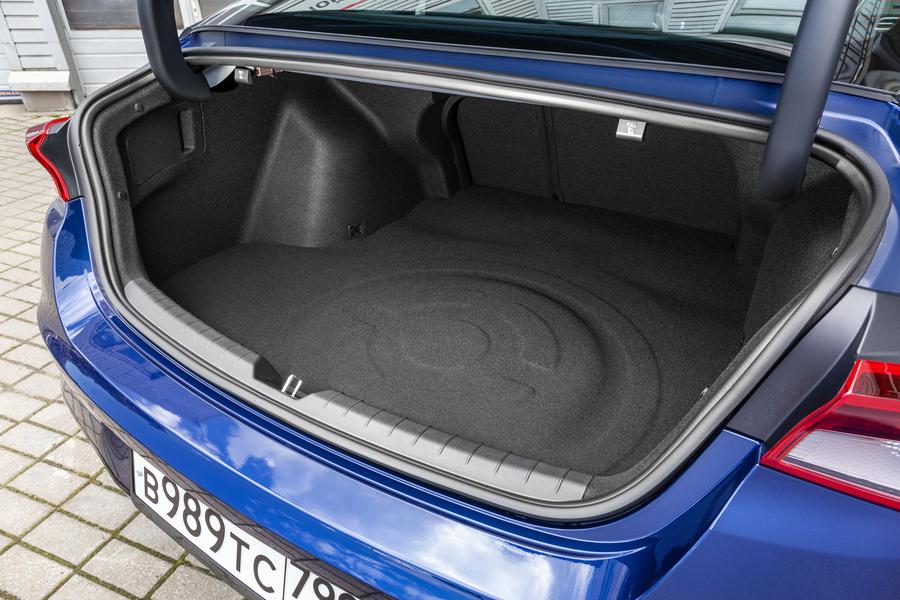
The trunk is large – 510 liters. But not for large items, because the opening is too small. Koreans traditionally do not indulge in pockets and nets
New platform and rides in a new way
The first impression is silence. The engine, if not turned, is not audible at all; the wind begins to hum only well over a hundred, and only tires against this background seem to be dominant, but also moderately. The difference with the previous Optima is tangible, and this was highlighted by a taxi ride on her in the evening of the same day. Suspension tuning is similar to Sonata’s – cool work on all types of irregularities, except for small ripples and sharp seams. Particularly impressed by the stability on the wavy village paths. Even at obscenely high speeds, shock absorbers dampen the buildup, and directional stability is practically independent of the coverage – this gives pleasant confidence in the car.
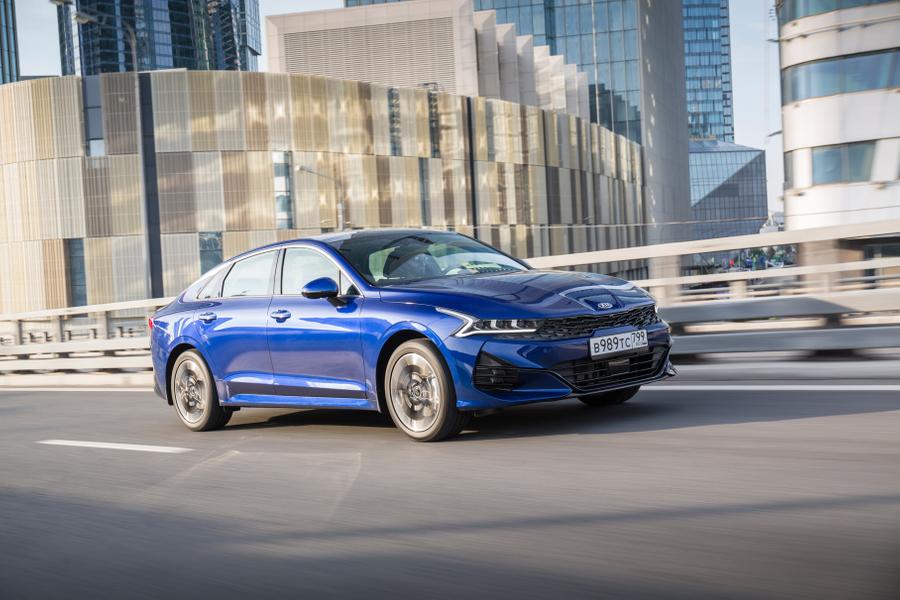
As usual in Korean cars, switching between driving modes does little for the driver. Nothing limits fast driving in “comfort”, but in the case of Kia it is better to leave the intelligent Smart mode
And the second pleasant surprise on the chassis is the balance of handling. The tried-and-true version of the GT Line does not differ from others in suspension settings, and all its sporty surroundings are purely external. By the standards of the K5 segment, it’s not a boring car at all, because when the driver tries to check in a corner, the tire grip keeps the beginning with all wheels, not just the front ones! With this setting, the sedan does not need to be begged to turn into a fast turn, and if you wish, you can even roll with the breeze for pleasure.

Among the heap of driver assistance systems (their full set plus a data projector on the windshield – the difference between the top version of GT Line + from GT Line), there are a couple of unusual ones. This is a delicate reminder that the car in front is moving (except perhaps on Subaru) and collision avoidance when turning at an intersection
True, the pedal will be on the floor all the time – despite the good declared dynamics, the new Smartstream 2.5 engine lacks momentum during active driving, and acceleration is perceived as minimally sufficient. This is the case when a good chassis asks for the capabilities of a turbo engine. Moreover, for corporate parks and calm drivers, the old 2.0 was left in the range. The engine is a little saved by the 8-speed automatic, with which you can profit both in dynamics and in fuel efficiency – of course, not simultaneously.

This photo shows especially how well the K5 masquerades as a fastback. The sedan’s ground clearance for the Global market has been increased from 135 to 155 mm. And in this generation, the manufacturer finally added a full heated windshield
Spherical hit in vacuum
In the absence of a direct clash with competitors, it makes no sense to spend more than a paragraph summing up the results. The car is balanced to the point of boredom, but not boring at all. With a striking design, thoughtful (with slight reservations) interior, a couple of unique gadgets, a good chassis, and a normal power plant. It’s nice that in the pursuit of current values, the developers haven’t forgotten the basic values - and the K5 not only sparkles with displays but also drives pleasantly. The main disadvantages are the lack of an alternative turbo engine and the ability to make the back row a little more comfortable, paying extra for a couple more positions. And to show the nuance and savor the details, we have planned an interesting comparison test with the K5. Wait on the Motor!
Kia K5 2.5 GDI
Like Equipment and details, handling do not like Lack of dynamic version Verdict Balanced model and potential segment hit 2497 cm³, petrol L4, 194 HP, 246 NmAKP-88.6 s; 210 km / hkg1 496 kg
Detailed specifications
| Kia K5 2.5 GDI GT Line + | |
|---|---|
| Engine’s type | petrol L4 |
| Working volume, cm³ | 2497 |
| Max. power, h.p. / rpm | 194/6100 |
| Max. moment, Nm / rpm | 246/4000 |
| Type of drive | front |
| Transmission | automatic, 8-speed |
| Front suspension | spring McPherson |
| Rear suspension | spring multi-link |
| Dimensions (LxWxH), mm | 4905x1860x1465 |
| Wheelbase, mm | 2850 |
| Curb weight, kg | 1496 |
| Trunk volume, l | 510 |
| Acceleration 0-100 km / h, s | 8.6 |
| Max. speed, km / h | 210 |
| Fuel consumption (comb.), L / 100 km | 7.1 |
| Fuel tank volume, l | 60 |
| Price | $20-30K |



